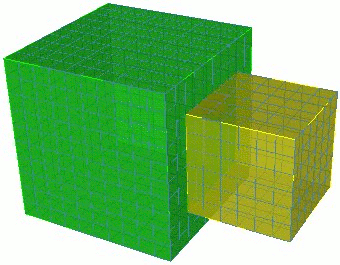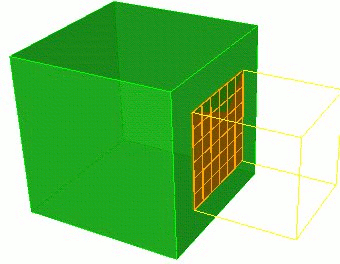
Cubit 15.8 User Documentation
To assist in various mesh editing tasks such as joining, a mesh-based imprinting capability is provided. The command
Imprint Mesh {Body | Volume} <id_list>
determines imprint locations using the mesh on the surfaces of the specified bodies or volumes. Regions of coincidence between the surfaces is determined by searching for coincident nodes in the mesh of the surfaces. Virtual geometry is then used to partition the surfaces and curves at the boundary of these regions of coincident mesh.
The imprint mesh functionality differs from a normal geometric imprint in the following ways:
The following is a trivial example of this capability. The following commands create two meshed blocks:
brick width 10
brick width 6
body 2 move x 8
volume 1 2 size 1
mesh volume 1 2
Figure 1 shows the results of these commands.

Figure 1. Two adjacent meshed volumes. The coincident meshes will form the basis of the imprint operation.
The mesh of the blocks can be joined by first doing a mesh-based imprint and then merging:
imprint mesh body 1 2
merge body 1 2
Figure 2. shows the results of the imprint operation. A meshed surface is created at the interface between the two meshed volumes. The nodes on the new surface are shared by the neighboring hexahedra of both volumes.

Figure 2. The imprinted surface. Adjacent volume meshes joined at the interface surface.